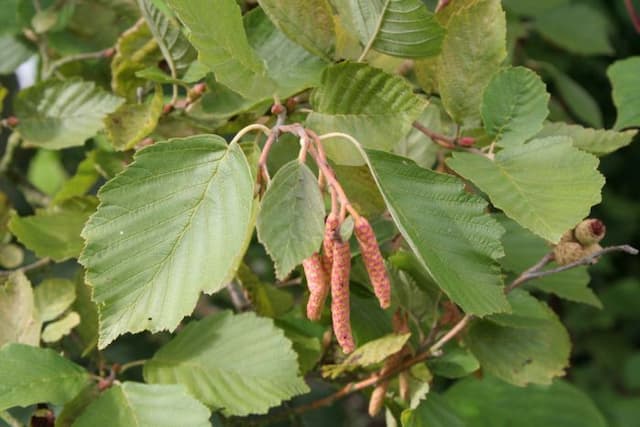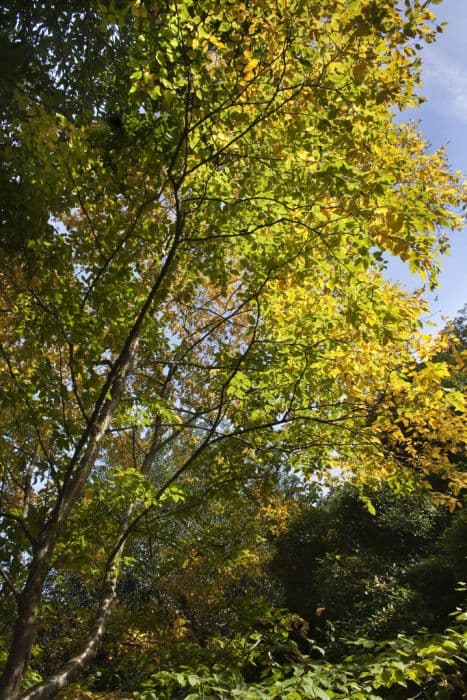Red Alder Alnus rubra

ABOUT
Alnus rubra, commonly known as red alder, is a deciduous tree distinguishable by its smooth gray bark when young, which becomes gray-brown with age, often fissured into small plates. Its leaves are simple and alternate, with a characteristic oval shape and a serrated edge; they are green above and paler below, often with rusty-hued hairs underneath. The red alder displays catkins, with male catkins being long and dangling, while the female catkins are shorter, oval, and become woody cones that persist on the tree through winter. In spring, the red alder is adorned with tiny reddish flowers. The tree's twigs are often sticky to the touch, and when the bark or twigs are scratched, they reveal a reddish inner wood, which is where the tree gets its common name.
About this plant
 Names
NamesSynonyms
Red Alder, Western Red Alder, Pacific Coast Alder, Oregon Alder, Northwest Alder.
Common names
Alnus oregona, Alnus rubra var. pinnatisecta, Alnus rubra f. pinnatisecta, Alnus rubra var. pumila, Alnus rubra var. rubra, Alnus sinuata, Betula rubra.
 Toxicity
ToxicityTo humans
The plant commonly known as red alder is not typically considered toxic to humans. There are no well-documented cases of poisoning from ingesting parts of the red alder, and it does not have a reputation for being a hazardous plant. Therefore, the consumption of this plant is not generally associated with any symptoms of poisoning or significant health consequences for humans.
To pets
Like humans, pets are not commonly affected by the red alder in terms of toxicity. The plant is not known to be poisonous to pets and does not usually cause adverse symptoms if ingested. As a result, there are no specific toxicity concerns or expected consequences for pets that consume parts of the red alder plant.
 Characteristics
CharacteristicsLife cycle
Perennials
Foliage type
Deciduous
Color of leaves
Green
Height
50 feet (15 meters)
Spread
25 feet (7.6 meters)
Plant type
Tree
Hardiness zones
5
Native area
North America
Benefits
 General Benefits
General Benefits- Erosion control: Red alder helps stabilize soil and prevent erosion, especially along streambanks and slopes.
- Nitrogen fixation: As a member of the birch family with nitrogen-fixing capabilities, red alder improves soil fertility by converting atmospheric nitrogen into a form usable by other plants.
- Habitat creation: Offers habitat and food sources (such as seeds and catkins) for a wide range of wildlife, including birds and small mammals.
- Reforestation: Used in reforestation projects, red alder can quickly colonize clear-cut or disturbed areas, facilitating the growth of a new forest.
- Wood products: The wood is utilized for furniture, cabinetry, and veneer products due to its workability and finish qualities.
- Stream enhancement: Contributes to the aquatic ecosystem by providing shade over streams, which helps maintain lower water temperatures, benefiting fish populations like salmon and trout.
- Agroforestry: Can be grown in agricultural settings in combination with crops or pasture, providing wind protection and enhancing biodiversity.
- Cultural significance: Native American tribes used red alder for various purposes, including carving and dye making, marking its cultural importance.
 Medical Properties
Medical Properties- Antibacterial: Alnus rubra bark has been used traditionally by indigenous peoples of the Pacific Northwest for its antibacterial properties.
- Anti-inflammatory: The bark contains tannins which may provide anti-inflammatory effects when used in topical applications.
- Astringent: Traditionally, the astringent qualities of red alder bark were used for treating skin irritations and inflammatory conditions.
- Lymphatic: Native American tribes have used red alder in a poultice to address swollen lymph nodes and related issues.
- Gastrointestinal aid: Historically used to treat a variety of digestive issues, including stomach pains and ulcers.
- Wound healing: The extracts from the bark have been applied in the form of poultices to wounds to promote healing.
 Air-purifying Qualities
Air-purifying QualitiesThis plant is not specifically known for air purifying qualities.
 Other Uses
Other Uses- Dye Production: The bark of the Alnus rubra, commonly known as red alder, contains tannins which can be used to produce a brownish-red dye for textiles.
- Woodworking: Red alder wood is easily workable and often used for furniture, cabinetry, and various woodworking crafts due to its smooth grain and ability to mimic cherry wood when stained.
- Smithing: Because of its hot-burning properties, red alder is sometimes used as fuel in blacksmithing and for forging metal.
- Fishing Aid: The bark and leaves of red alder contain tannins that can be used to tan fishing nets, increasing their durability and lifespan.
- Photographic Development: Historically, tannin extracts from red alder were used as an ingredient in photographic developer solutions.
- Animal Bedding: The wood shavings of red alder are used as animal bedding due to its absorbency and soft texture.
- Mushroom Cultivation: The wood chips of red alder can be used as a medium for cultivating certain types of mushrooms, which thrive on the wood’s composition.
- Ice Cream Flavoring: The bark has been used historically as a flavoring agent in certain traditional recipes for ice cream.
- Ornamental Uses: Red alder trees are sometimes planted for ornamental purposes because of their attractive shape and the catkins they produce.
- Erosion Control: The extensive root system of red alder helps stabilize soil and control erosion on riverbanks and wetlands.
Interesting Facts
 Feng Shui
Feng ShuiThe Red Alder is not used in Feng Shui practice.
 Zodiac Sign Compitability
Zodiac Sign CompitabilityThe Red Alder is not used in astrology practice.
 Plant Symbolism
Plant Symbolism- Protection: The Alnus rubra, commonly known as the Red Alder, often grows quickly in areas that have been disturbed or damaged. As such, it has come to symbolize protection and the guarding of one's environment.
- Resilience: Red Alders have the ability to restore fertility to the soil, symbolizing the plant's resilience and its role in healing and regeneration of the land. This resilience mirrors the human capacity for recovery and renewal.
- Adaptability: Able to thrive in a variety of conditions and often one of the first species to colonize an area post-disturbance, the Red Alder is a symbol for adaptability and the ability to prosper through change.
 Water
WaterRed alder should be watered deeply and infrequently, which encourages the roots to grow deeper and enhances drought tolerance. It is recommended to water the plant with about 2-3 gallons per session for young trees, increasing the amount as the tree matures due to its larger root system. In general, watering every two weeks during the dry season is sufficient, but it may require more frequent watering during prolonged dry spells, especially when the tree is establishing. Make sure the soil is well-drained as red alder does not like to sit in waterlogged soil.
 Light
LightRed alder thrives in full sunlight but can tolerate partial shade, especially in hotter climates. Ideally, the plant should receive at least six hours of direct sunlight per day. The best spot for the red alder would be an open area away from tall buildings or dense forest canopies that can block the sunlight.
 Temperature
TemperatureRed alder prefers moderate temperatures and is hardy in USDA zones 4 through 9. It can withstand a minimum temperature of around -30°F and can survive up to a maximum temperature of about 100°F. The ideal temperature range for growing red alder is between 50°F and 75°F which balances growth and avoids stress from extremes.
 Pruning
PruningPruning red alder is essential to maintain its shape, remove dead or diseased branches, and promote strong structure. Light pruning can be done at any time of the year, but major pruning should be conducted during the dormant season, preferably in late winter or early spring before new growth begins. Pruning every two to three years is often enough to keep the tree healthy and well-formed.
 Cleaning
CleaningNot needed
 Soil
SoilRed Alder thrives in moist, well-drained soils with a slightly acidic to neutral pH of 5.5 to 7.0. An ideal soil mix can be formed by blending loam, sand, and organic compost, ensuring good drainage and fertility to support its growth.
 Repotting
RepottingRed Alder trees are generally not repotted as they are fast-growing, large trees; instead, they are planted in a suitable location where they can grow uninterrupted.
 Humidity & Misting
Humidity & MistingRed Alder prefers moderate to high humidity and can tolerate the varied humidity levels typically found in its natural outdoor habitat.
 Suitable locations
Suitable locationsIndoor
Red Alder is too large for indoor growth.
Outdoor
Plant Red Alder in moist soil; full sun to partial shade.
Hardiness zone
5-9 USDA
 Life cycle
Life cycleRed Alder (Alnus rubra) begins its life as a seed released from mature cones in the fall or winter, which then germinates on moist soil in spring. The seedling rapidly grows into a young sapling, thanks to a symbiotic relationship with nitrogen-fixing bacteria in its root nodules, which enriches the soil. As it matures, the red alder develops a straight trunk and reaches reproductive maturity at about 20 years, producing catkins that will eventually form the cones containing the seeds. The tree continues to grow and can reach up to 30 meters in height, with its peak productive and reproductive period lasting up to 60 years. As it reaches the end of its lifecycle, typically around 80-100 years, the red alder begins to decline, with reduced foliage and seed production, eventually falling prey to disease, rot, or environmental stress. The decaying wood enriches the forest floor, while new alder seeds sprout to begin the cycle anew.
 Propogation
PropogationPropogation time
Late winter-early spring
The most popular method of propagating the Red Alder (Alnus rubra) is through seed. The best time for seed collection is when the cones have dried on the tree, which usually occurs in late fall. Once collected, the seeds require a period of cold stratification to break their dormancy; this involves exposing the seeds to cool temperatures of about 34 to 40 degrees Fahrenheit (1 to 4 degrees Celsius) for one to three months. After stratification, the seeds can be sown on the surface of a well-drained seed starting mix. Kept moist and under the right light conditions, germination should occur within a few weeks. It’s important to note that seeds have a short viability period, so they should be sown soon after stratification. Seedlings can be transplanted outdoors in spring once the risk of frost has passed and they have developed strong root systems.









